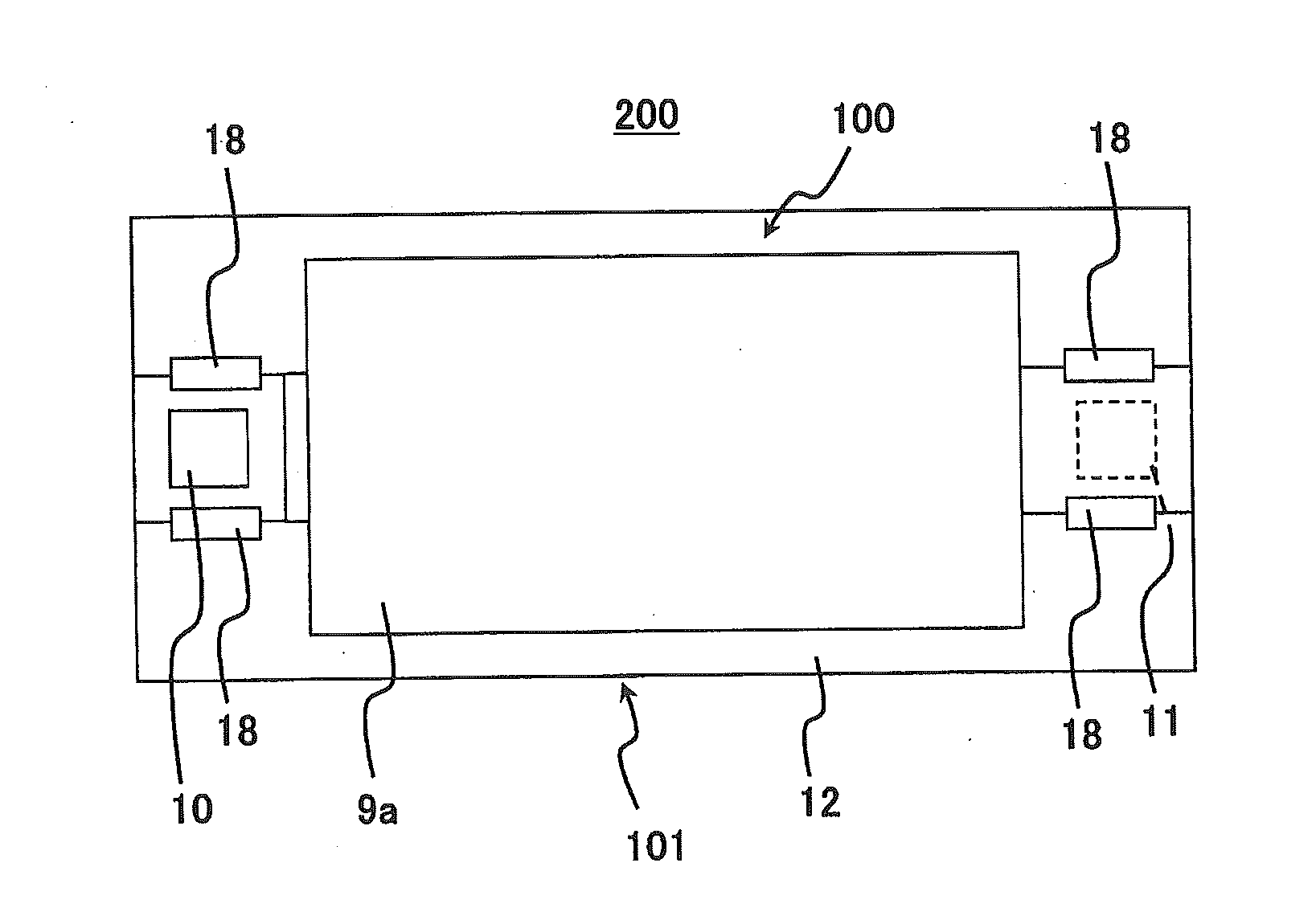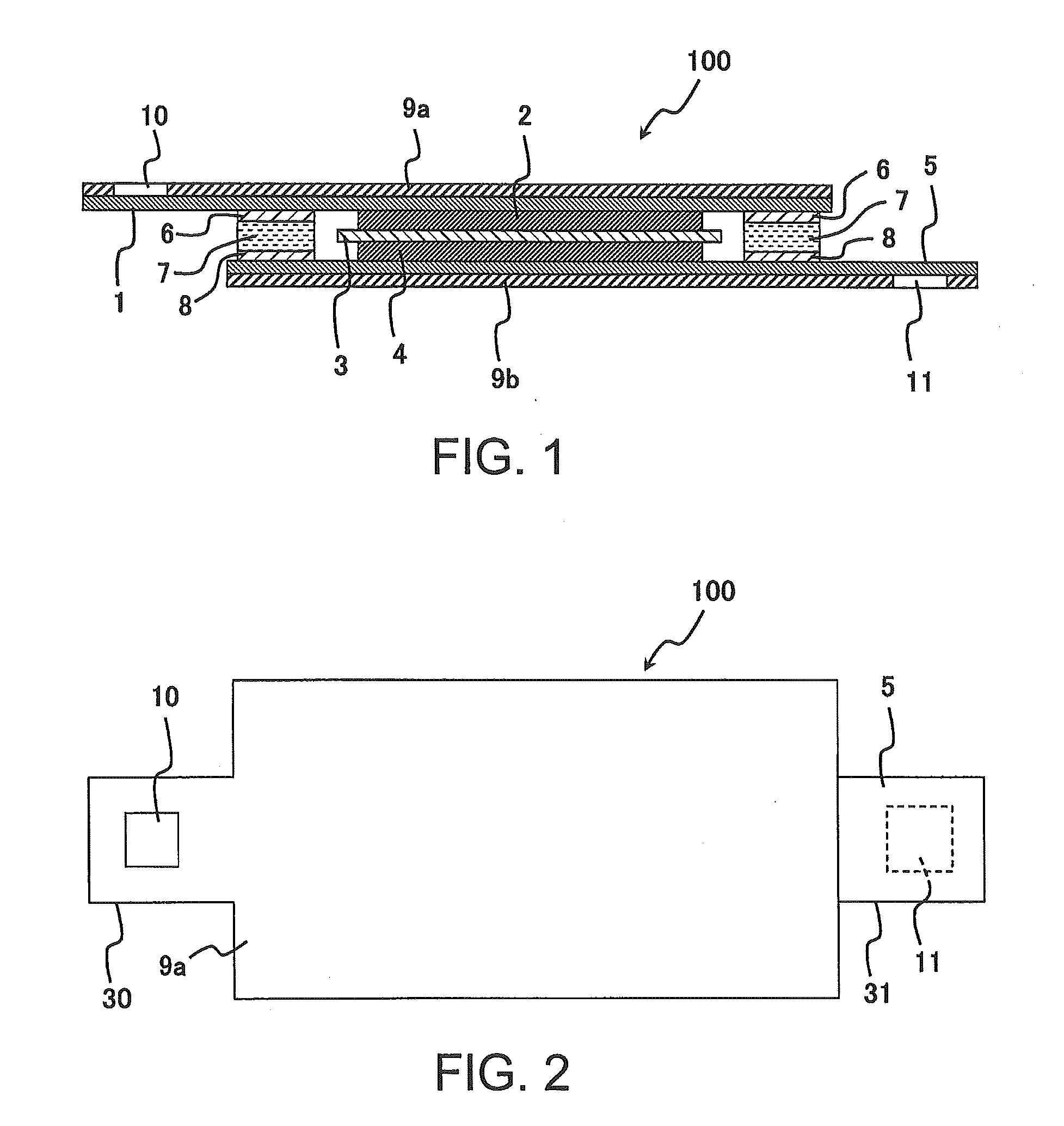Non-aqueous secondary battery, mounted unit, and method for manufacturing non-aqueous secondary battery
- Summary
- Abstract
- Description
- Claims
- Application Information
AI Technical Summary
Benefits of technology
Problems solved by technology
Method used
Image
Examples
example 1
[0158]90 wt % of lithium manganate having a spinel structure, 5 wt % of graphite powder having an average particle diameter of 6 μm and 2 wt % of acetylene black as conductivity-imparting agents, and 3 wt % of PVDF as a binder were weighed, and dispersed and mixed in N-methylpyrrolidone (hereinafter referred to as “NMP”) to obtain a positive-electrode ink. The positive-electrode ink produced by the above-mentioned method was printed and applied to an aluminum foil having a thickness of 40 μm by screen printing, a rear surface of the aluminum foil having attached thereto a liquid crystal polyester having a thickness of 50 μm, and NMP, which was a dispersion solvent, was removed by heat-drying. After that, the resultant was subjected to compression molding with a roller press machine, and thus a positive electrode including the liquid crystal polyester and the aluminum foil and having a total thickness of 140 μm was produced.
[0159]As a negative-electrode active material, MCMB manufact...
example 2
[0161]90 wt % of cobalt, aluminum-substituted lithium nickelate (LiNi0.80Co0.15Al0.05O2) having a layered rock-salt structure, 5 wt % of graphite powder and 2 wt % of acetylene black as conductivity-imparting agents, and 3 wt % of PVDF as a binder were weighed, and dispersed and mixed in N-methylpyrrolidone (hereinafter referred to as “NMP”) to obtain a positive-electrode ink. The positive-electrode ink produced by the above-mentioned method was printed and applied to an aluminum foil having a thickness of 40 μm by screen printing, a rear surface of the aluminum foil having attached thereto a liquid crystal polyester having a thickness of 50 μm, and NMP, which was a dispersion solvent, was removed by heat-drying. After that, the resultant was subjected to compression molding with a roller press machine, and thus a positive electrode including the liquid crystal polyester and the aluminum foil and having a total thickness of 140 μm was produced.
[0162]As a negative-electrode active ma...
example 3
[0164]70% of an organic radical polymer, poly(2,2,6,6-tetramethylpiperidinyloxy-4-yl methacrylate), 14% of vapor grown carbon fiber, 7% of acetylene black, 8% of carboxymethyl cellulose, and 1% of Teflon (trademark) were weighed, and dispersed and mixed in water to obtain a positive-electrode ink. The positive-electrode ink produced by the above-mentioned method was printed and applied to an aluminum foil having a thickness of 40 μm by screen printing, a rear surface of the aluminum foil having attached thereto a liquid crystal polyester having a thickness of 50 μm, and water, which was a dispersion solvent, was removed by heat-drying. After that, the resultant was subjected to compression molding with a roller press machine, and thus a positive electrode including the liquid crystal polyester and the aluminum foil and having a total thickness of 170 μm was produced.
[0165]As a negative-electrode active material, MCMB manufactured by Osaka Gas, Co., Ltd. graphitized at 2,800° C. was ...
PUM
| Property | Measurement | Unit |
|---|---|---|
| Thickness | aaaaa | aaaaa |
| Thickness | aaaaa | aaaaa |
| Current | aaaaa | aaaaa |
Abstract
Description
Claims
Application Information
 Login to View More
Login to View More - R&D
- Intellectual Property
- Life Sciences
- Materials
- Tech Scout
- Unparalleled Data Quality
- Higher Quality Content
- 60% Fewer Hallucinations
Browse by: Latest US Patents, China's latest patents, Technical Efficacy Thesaurus, Application Domain, Technology Topic, Popular Technical Reports.
© 2025 PatSnap. All rights reserved.Legal|Privacy policy|Modern Slavery Act Transparency Statement|Sitemap|About US| Contact US: help@patsnap.com



